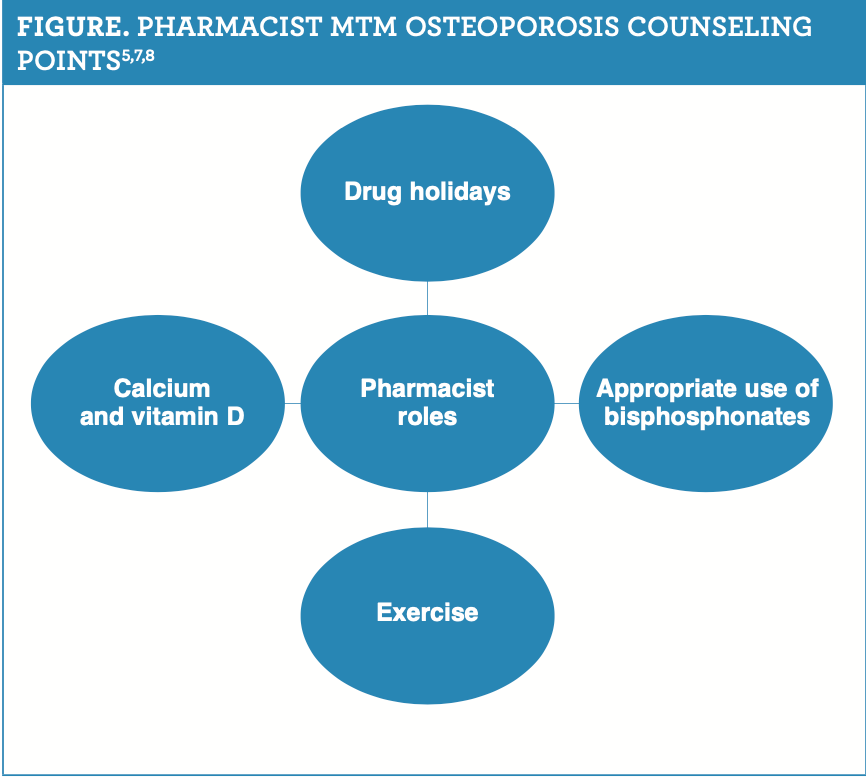Publication
Article
Pharmacy Times
Pharmacists Play a Key Role in Treating Osteoporosis
Author(s):
Patient education is a critical component of helping patients manage this common chronic condition.
Osteoporosis is a common bone disease that affects about 54 million individuals in the United States.1
In fact, evidence suggests that approximately 1 in 2 women and up to 1 in 4 men aged 50 and older will experience a bone fracture because of osteoporosis.1 It has always been considered one of the “core” chronic conditions for which patients can receive benefit from medication therapy management services (MTM).2 This emphasizes the important role that pharmacists can play in osteoporosis management through MTM to prevent fractures.
One study examined clinical trial data and guidelines to evaluate drug holidays for patients with osteoporosis and the pharmacist’s role in MTM services.3 According to study results, after 3 to 5 years of bisphosphonate therapy, patients with mild to moderate fracture risk may consider discontinuing the medication.3 Clinical practice guidelines agree with this time frame for considering a “bisphosphonate drug holiday;”4,5 however, those at high risk for a fracture should continue therapy.4,5 Pharmacists can play a vital role through medication adherence education and monitoring.3 One retrospective study compared collaborative pharmacist-physician to physician-only management in patients with high-risk osteoporosis at a family medicine clinic.6 The results showed that collaborative management resulted in higher rates of patients receiving antifracture therapy prescriptions (P < .001) and calcium and vitamin D recommendations (P < .001) compared with rates for physician- only management.6 Collaborative practices involving pharmacists can improve osteoporosis management in the ambulatory-care setting.6
CASE STUDY AND COUNSELING PEARLS
TM is a 60-year-old woman who recently started alendronate (Fosamax) 70 mg once a week for the treatment of postmenopausal osteoporosis. During a targeted medication review, the pharmacist discusses this new therapy with TM and recommends other measures for bone health (see figure5,7,8).

In an interview, Callie Pray, PharmD, an MTM pharmacist for independent pharmacy Holder Drug in Alva, Oklahoma, discussed common counseling points for osteoporosis management.
“Most osteoporosis patients I have the opportunity to counsel through MTM take alendronate,” Pray said.
The most common adherence issue that she encounters is patients forgetting to take their medications, especially with the once-weekly dosing. With the once-a-week regimen of alendronate, it is important for patients to set an alarm or a reminder on their smartphones for the mornings that they need to take their dose. Alternate adherence methods include placing notes at prominent spots in their homes or writing or setting calendar reminders.
“Alendronate should be taken first thing in the morning with a full glass [6 to 8 oz] of plain water at least 30 minutes before eating or drinking anything else or taking any other medications or supplements,” Pray said.
Beverages, such as coffee, tea, or juice, or food can decrease alendronate absorption.7 Pharmacists should instruct patients to swallow the tablet whole and not to chew, crush, or suck on it. After taking alendronate, it is also important for patients to not lie down for at least 30 minutes to help the medication reach the stomach faster and prevent irritation of the esophagus.7
“Patients should notify their doctor right away if they notice any new chest pain, worsening heartburn, pain when swallowing, and any unusual bone, joint, or muscle pain while taking alendronate,” Pray said.
Because 1 rare adverse effect of alendronate is jaw osteonecrosis, it is important for patients to let dentists know about this medication before having dental work done.7
Individuals typically need 1000 to 1200 mg of calcium per day, depending on age, according to the National Osteoporosis Foundation.8 Also, patients younger than 50 years should take 400 to 800 international units (IU) daily of vitamin D, and individuals aged 50 and older should have 800 to 1000 IU daily.8 It is best to get calcium through the diet, and some good sources include dairy products, such as cheese, milk, and yogurt.8 As there is mixed evidence regarding whether calcium supplements increase the risk of cardiovascular disease,9 it is better to try and get calcium from food sources and then supplement if necessary. Vitamin D is more difficult to obtain through diet, so supplementation is usually needed.8
“Patients can also help their bones stay strong and healthy by exercising, limiting alcohol and caffeine intake, and not smoking,” Pray said.
Jennifer Gershman, PharmD, CPh, is a drug information pharmacist and Pharmacy Times® contributor who resides in South Florida.
REFERENCES
- What is osteoporosis and what causes it? National Osteoporosis Foundation. Accessed August 5, 2020. https://www.nof.org/patients/what-is-osteoporosis/
- Medication therapy management in pharmacy practice: core elements of an MTM service model. American Pharmacists Association. March 2008. Accessed August 5, 2020. https://www.pharmacist.com/sites/default/files/files/core_elements_of_an_mtm_ practice.pdf
- Murphy-Menezes M. Role of the pharmacist in medication therapy manage- ment services in patients with osteoporosis. Clin Ther. 2015;37(7):1573-1586. doi:10.1016/j.clinthera.2015.03.023
- Eastell R, Rosen CJ, Black DM, Cheung AM, Murad MH, Shoback D. Pharmacological management of osteoporosis in postmenopausal women: an Endocrine Society clinical practice guideline. J Clin Endocrinol Metab. 2019;104(5):1595-1622. doi:10.1210/jc.2019-00221
- Medication and treatment adherence: the hows and whys of osteoporosis medi- cations. National Osteoporosis Foundation. Updated September 7, 2018. Accessed August 5, 2020. https://www.nof.org/patients/treatment/medicationadherence/
- Bowers BL, Drew AM, Verry C. Impact of pharmacist-physician collabora- tion on osteoporosis treatment rates. Ann Pharmacother. 2018;52(9):876-883. doi:10.1177/1060028018770622
- Alendronate (oral route). Mayo Clinic. Updated July 1, 2020. Accessed August 5, 2020. https://www.mayoclinic.org/drugs-supplements/alendronate-oral-route/descrip- tion/drg-20061571
- Calcium and vitamin D. National Osteoporosis Foundation. Updated February 26, 2018. Accessed August 5, 2020. https://www.nof.org/patients/treatment/calcium- vitamin-d/
- Reid IR, Birstow SM, Bolland MJ. Calcium and cardiovascular disease. Endocrinol Metab (Seoul). 2017;32(3):339-349. doi:10.3803/EnM.2017.32.3.339







